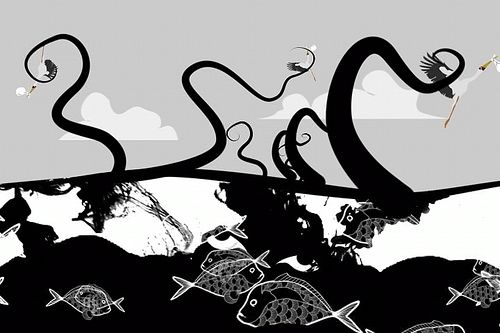 NATIONAL GEOGRAPHIC– A massive deep say coral die-off was discovered this week about 7
miles (11 kilometeres) southwest of the source of the Gulf of Mexico
oil spill, scientists announced Thursday.
NATIONAL GEOGRAPHIC– A massive deep say coral die-off was discovered this week about 7
miles (11 kilometeres) southwest of the source of the Gulf of Mexico
oil spill, scientists announced Thursday.
Large communities of several types of bottom-dwelling coral were found covered with a dark substance at depths of about 4,600 feet (1,400 meters) near the damaged Deepwater Horizon wellhead, according to a scientific team on the National Oceanic and Atmospheric Administration (NOAA) ship Ronald H. Brown.
“The coral were either dead or dying, and in some cases they were simply exposed skeletons,” said team member Timothy Shank of Woods Hole Oceanographic Institution.
“I’ve never seen that before. And when we tried to take samples of the coral, this black—I don’t know how to describe it—black, fluffylike substance fell off of them.”
“Smoking Cannon” Evidence for Gulf Oil Spill
About 90 percent of 40 large groups of severely damaged soft coral were discolored and either dead or dying, the researchers say. A colony of hard coral at another site about 1,300 feet (400 meters) away was also partially covered with a similar dark substance that’s likely oil from the BP spill.
(See pictures of ten animals at risk from the Gulf oil spill.)
“Corals do die, but you don’t see them die all at once,” said cruise lead scientist Charles Fisher of Penn State University. “This … indicates a recent catastrophic event,” he told National Geographic News.
The circumstantial evidence is strong enough to be considered a “smoking gun” that the BP spill could have played a role in the coral deaths, Fisher said in a statement.
For one thing, the dead coral was found at 4,600 feet (1,400 meters), about the same depth as the now sealed wellhead, and currents at the time of the April 20 blowout would have carried the oil southwesterly, scientists say.
“The proximity of the site to the disaster, the depth of the site, the clear evidence of recent impact, and the uniqueness of the observations all suggest that the impact we have found is linked to the exposure of this community to either oil, dispersant, extremely depleted oxygen, or some combination of these or other water-borne effects resulting from the spill,” Fisher said in a statement.
Scientists have predicted for months that the oil is not degrading and that the toxic ingredients may be having dire and unseen effects on the Gulf’s marine life.
In August, for example, University of Florida (USF) oceanographer David Hollander discovered that deep-sea creatures showed a “strong toxic response” to Gulf water containing hydrocarbons, an ingredient of oil.
Hollander’s USF colleague John Paul told National Geographic News Friday that the newly discovered coral die-off is more of a “smoking cannon.”
“It doesn’t surprise me,” he said. “It could be the tip of the iceberg of all kinds of weird things we’re going to see in the Gulf of Mexico in the next three to five years” due to the Gulf spill, Paul said.
Even so, both Fisher and Paul strongly caution that sediment and coral samples need to be tested in the lab to confirm a Gulf-spill origin.
Read the full article on the Giant Coral Die-Off.
Written and researched by, Kathleen Jones aboard the Ronald H. Brown for National Geographic News
Animation by Fuseman/flickr
© COPYRIGHT NATIONAL GEOGRAPHIC, 2010










